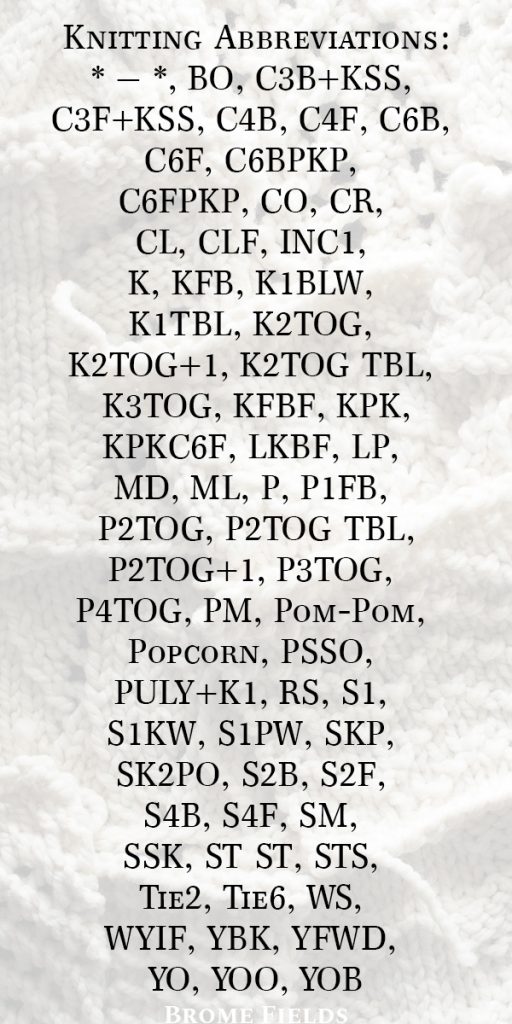Knitting Abbreviations Plus Video Tutorials
This post may contain affiliate links. Please read my disclosure policy.
Browse over 250 knitting abbreviation library of video tutorials. Plus, some knit stitches.
Most of the abbreviations below have examples. The best way to find all the examples for an abbreviation is to put the abbreviation you’re looking for into the search bar at the top of the page, press enter and all the patterns & stitches that use that abbreviation will appear.

Knitting Abbreviations:
* – * – repeat pattern
C3B+KSS – slip 2 STS onto a cable needle hang at the BACK of your work, knit the slipped ST 2 rows below, K2 STS from the cable needle {Example}
C3F+KSS – slip 1 STS onto a cable needle hang at the FRONT of your work, knit 2 STS, and then knit the 1 stitch from the cable needle {Example}
C6BPKP – cable 6 back, slip 3 sts onto the cable needle, hold at the back of your work, P1, K1, p1 off your left-hand needle and then P1, K1, p1 off the cable needle {Example}
C6FPKP – cable 6 front, slip 3 sts onto the cable needle, hold at the front of your work, P1, K1, p1 off your left-hand needle and then P1, K1, p1 off the cable needle {Example}
CO – cast-on {long-tail cast-on method}
CR – Knit into the front of the second stitch, and then the front of the first stitch and then slip both stitches off {Examples: 1, 2, 3, 4 & 5}
CL – Knit into the back of the second stitch, and then the back of the first stitch and then slip both off
CLF – Knit into the back of the second stitch, and then the front of the first stitch and then slip both off {Example}
INC1 – make 1 stitch {I use a backwards loop}
K – knit stitches {K1 means to knit 1 stitch}
K1BLW – insert right needle, as if to knit, into the stitch below and then knit {Example}
K1TBL – knit 1 stitch through the back loop {Example}
K2TOG – knit 2 stitches together
K2TOG+1 – knit 2 together plus knit 1 into the first loop
K2TOG TBL – knit 2 together, through the back loop {Examples: 1 & 2}
K3TOG – knit 3 stitches together, creating 1 stitch {Examples 1, 2 & 3}
KFBF – knit into the front, back and then the front again of the same stitch {Example}
KPK – knit, purl, knit into the YO in the previous row {Examples 1, 2 & 3}
KPKC6F – cable 6 front, slip 3 sts onto cable needle, knit 3 sts and then K1, P1, K1 off the cable needle {Example}
LKBF – Knit through the back loop of the second stitch on the left needle, then knit through the front of the first stitch, and drop them both from the needle at the same time {Example}
LP – Purl the second stitch on the left needle, then purl the first stitch, and drop them both from the needle at the same time {Example}
MD – Make Daisy – insert needle in hole 3 rows below the 2nd ST, pull a loop through the hole, K2, pull a 2nd loop through the same hole, K2, pull a 3rd loop through the same hole {Example}
ML – Make Loop {In this case, a video is worth a thousand words, click to watch the video}
P – purl stitches {P2 means to purl 2 stitches}
P2TOG – purl 2 stitches together
P2TOG TBL – purl 2 stitches together, through the back loop {Examples 1, 2, 3 & 4}
P2TOG+1 – purl 2 sts together, but do not slip from needle, and then purl the first stitch again, and slip both stitches from needle together {Example}
P3TOG – purl 3 stitches together {Example}
P4TOG – purl 4 sts together {Example}
Popcorn – K into the front and back of the loop twice, and then slip the 2nd, 3rd and 4th stitches over the 1st {Example}
PSSO – pass slipped stitch over {Examples 1, 2, 3, 4 & 5}
PULY+K1 – pick up the long yarn created by the K1BLW, slip the knit stitch as if to knit onto the right needle, put both stitches back onto the left needle and then knit both together {Example}
RS – right side
S1KW – slip one stitch knit-wise
S1PW – slip one stitch purl-wise
SKP – slip 1 stitch purl-wise, knit the next stitch, pass the slipped stitch over the knitted stitch
SK2PO – slip 1 stitch purl-wise, knit 2 stitches together, pass the slipped stitch over the 2 stitches knitted together, decreasing 2 stitches {Example}
S2B – Slip 2 stitches onto a cable needle, holding the stitches in back {Example}
S2F – Slip 2 stitches onto a cable needle, holding the stitches in front {Example}
S4B – Slip 4 stitches onto a cable needle, holding the stitches in back {Example}
S4F – Slip 4 stitches onto a cable needle, holding the stitches in front {Example}
STS – stitches
Tie2 – slip 2 sts onto a cable needle, wrap the working yarn from left to right around the 2 sts twice and then K2 sts off the cable needle {Example}
Tie6 – slip 6 sts onto a cable needle, wrap the working yarn from left to right around the 6 sts twice and then K2, P2, K2 sts off the cable needle {Example}
WS – wrong side
WYIF – with yarn in front {Same as YFWD}
YBK – with the yarn in the back of the work
YFWD – yarn forward, in the front of the work {Same as WYIF}
YOO – yarn over over, so you will yarn over twice {Examples 1, 2 & 3}
YOB – bring working yarn over top of needle to the back, this produces a yarn over {Example}
